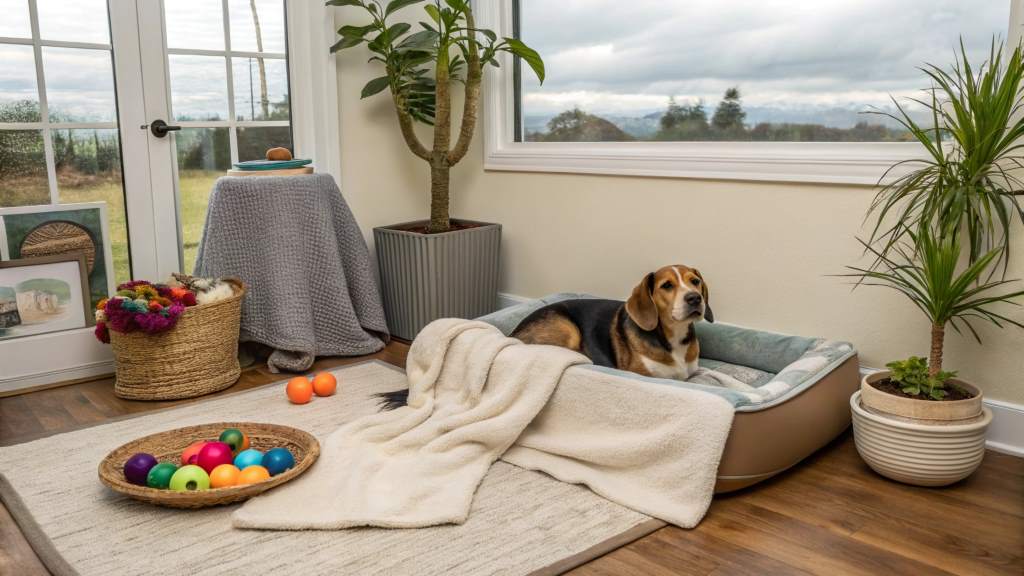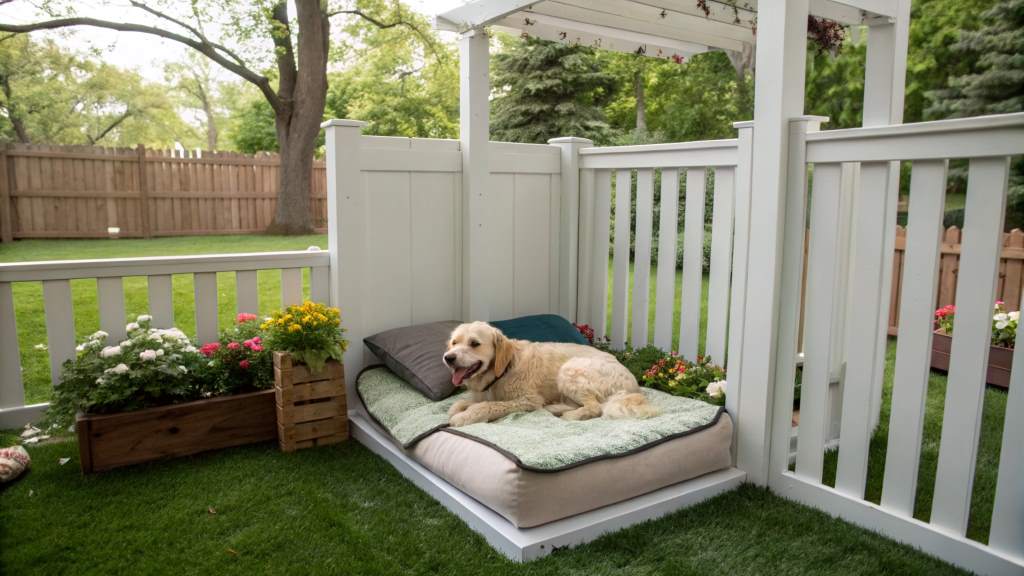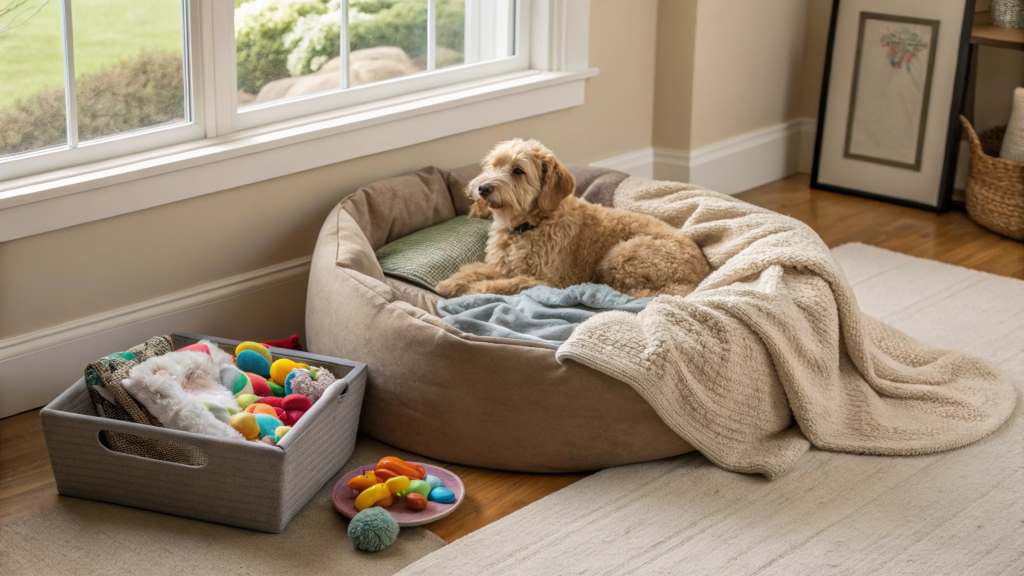Creating a safe space for your dog is essential for their well-being and your peace of mind. A dog’s environment significantly influences their physical health, emotional stability, and overall happiness. Whether you’re a new pet parent or a seasoned dog lover, crafting a haven tailored to your furry friend’s needs ensures they feel secure, loved, and protected. Let’s explore how to build a sanctuary for your canine companion while incorporating expert insights and actionable tips.
Explore Begardenly for more tips on enriching your pet’s environment.
Understanding Your Dog’s Needs
Every dog is unique, with their own preferences and triggers. A safe space should cater to their specific needs. Dogs require a quiet, comfortable area to retreat when stressed or tired. Think of it as their personal bedroom—a place free from overwhelming noise or activity.
Studies indicate that dogs with access to a designated retreat are less likely to exhibit destructive behaviors, highlighting the importance of this simple yet effective solution. Observing your dog’s habits can help you identify what makes them comfortable. For example, do they prefer soft bedding or a cool tile floor? Paying attention to these details can make all the difference.
Ensuring a Toxic-Free Environment
While designing a safe space for your dog, it’s crucial to eliminate any potential hazards. For example, consider the impact of harmful plants. Pet owners often wonder, will dogs eat foxglove? This beautiful but toxic plant poses severe risks to dogs if ingested. To avoid accidents, research the plants in and around your home, removing those that could harm your pet.
Beyond plants, look out for cleaning supplies, small objects, and wires that your dog could chew. Use baby gates, storage boxes, or designated shelves to keep dangerous items out of reach.
Selecting the Right Location
The placement of your dog’s safe space is pivotal. Choose an area away from heavy foot traffic, loud appliances, or other pets that might disturb them. Bedrooms, under-the-stairs nooks, or even a corner of the living room can serve as ideal locations.
Ensure the area receives adequate ventilation and lighting while being shielded from extreme temperatures. Dogs, like humans, feel better in environments that mimic natural conditions. Use blackout curtains or soundproofing solutions if the space is prone to external disturbances.
Comfortable Bedding and Furnishings
Comfort is key to creating a haven for your dog. Select a bed that matches their size, age, and health requirements. Orthopedic beds are excellent for older dogs or those with joint issues, while young, energetic pups might prefer something more durable. Add soft blankets, pillows, or even a worn shirt with your scent to make the area feel familiar and comforting.
Organize their favorite toys, chewables, and even a few snacks to keep them entertained. Avoid cluttering the space, as dogs tend to prefer a clean, organized environment.
Establishing a Routine
Consistency is vital in helping your dog feel at ease in their new safe space. Introduce them to the area slowly, encouraging them to use it with positive reinforcement. Offer treats, praise, or their favorite toy each time they settle in the designated spot.
Building a routine also involves ensuring your dog has access to their space during stressful situations. For instance, during thunderstorms or when guests visit, allow them to retreat to their safe zone without interruption.
Sound and Smell Sensitivities
Dogs have acute senses of hearing and smell, making these factors crucial when designing their safe space. Avoid placing their area near noisy appliances like washing machines or televisions. Use white noise machines or calming music to drown out harsh sounds.
Similarly, introduce calming scents like lavender or chamomile using pet-safe diffusers. These can significantly reduce anxiety and create a relaxing atmosphere. Avoid strong, artificial fragrances that might overwhelm their sensitive noses.
Securing the Area
Safety also means ensuring your dog cannot accidentally escape their designated space. Use sturdy barriers, gates, or doors to contain the area. If the safe space is outside, inspect fencing and remove any sharp objects or gaps that your dog could exploit.
Microchipping and proper ID tags are additional steps to protect your pet in case of accidental escapes.
Temperature and Climate Control
Maintaining a comfortable temperature in your dog’s safe space is critical. Dogs are sensitive to extreme heat and cold, which can lead to stress or even health issues. In warmer months, provide a cooling mat or ensure their space is well-ventilated. For colder weather, consider heated blankets or insulating materials to keep the area cozy.
Position the safe space away from direct sunlight or drafty windows. A consistent climate ensures your dog feels secure and comfortable year-round, preventing temperature-related discomfort.
Personalized Touches for Your Dog’s Comfort
Adding personal elements to your dog’s safe space helps them feel more at home. Items like a favorite toy, a familiar blanket, or even a picture of you (yes, dogs recognize familiar faces!) can make the area feel more reassuring.
If your dog has any specific habits—such as digging into bedding or chewing—incorporate solutions like durable fabrics or chew-resistant materials. Small gestures tailored to their preferences can enhance their overall comfort.
Incorporating Calming Tools
For dogs prone to anxiety or restlessness, calming tools can be invaluable. Weighted blankets or anxiety wraps, like the ThunderShirt, mimic a comforting hug and are particularly effective during stressful situations.
Interactive toys filled with treats or puzzles can also keep your dog mentally engaged, reducing stress and boredom. Natural supplements like CBD treats or chamomile-based snacks may offer additional relaxation benefits, but always consult your veterinarian before introducing new products.
Regular Maintenance and Cleanliness
Keeping your dog’s safe space clean is essential for their health and comfort. Regularly wash bedding, vacuum the area, and disinfect toys to prevent the buildup of dirt, bacteria, and allergens.
Dogs are highly sensitive to smells, so using pet-safe cleaning products ensures their environment remains inviting without introducing harsh chemicals. A clean, fresh-smelling space is more likely to be a place your dog enjoys retreating to.
Training Your Dog to Use Their Safe Space
Encouraging your dog to use their safe space is an ongoing process. Initially, you may need to guide them gently into the area, using treats and a soothing tone. Never force them into the space, as this could create negative associations.
Reward them with praise and small treats whenever they voluntarily enter the area. Over time, your dog will naturally recognize this space as their sanctuary, a retreat from stress or overstimulation.
Recognizing Signs of Discomfort
While a safe space is designed to reduce stress, it’s essential to monitor your dog’s behavior. If they seem hesitant to use the area or exhibit signs of discomfort—such as whining, pacing, or scratching excessively—it could indicate that adjustments are needed.
Evaluate the environment for potential stressors, like noise, lighting, or temperature, and make the necessary changes to ensure it remains a positive space.
Outdoor Safe Spaces
If your dog loves spending time outside, consider creating a safe outdoor retreat. Use a fenced-in area with shade, water access, and a comfortable surface for lounging. Avoid using gravel or rough materials that could hurt their paws.
Include interactive features, such as agility equipment or sandbox digging areas, to keep them entertained and engaged while staying secure.
Safe Space for Multiple Dogs
If you have more than one dog, designing a shared safe space requires additional considerations. Ensure the area is large enough for each dog to have their own spot to retreat. Provide separate bedding, toys, and feeding stations to prevent competition or territorial disputes.
Some dogs may prefer individual spaces, so observe their interactions and adjust accordingly. The goal is to create a harmonious environment where all pets feel secure and content.
Safe Space During Travel
Creating a safe space isn’t limited to your home. When traveling, bring familiar items like your dog’s blanket or bed to help them feel at ease in unfamiliar surroundings.
Use portable crates or travel-friendly playpens to provide a secure environment during road trips or stays at new locations. Familiarity and routine are critical in reducing travel-related anxiety.
Creating a Safe Space for Puppies
Puppies require extra attention when designing a safe space. Since they are naturally curious and teething, prioritize safety by removing small or hazardous items. Use puppy-proof gates and chew-resistant materials to prevent accidents.
Include toys that stimulate their growing minds and provide plenty of soft bedding for naps. Early exposure to a safe space fosters a sense of security as they grow.
The Emotional Benefits of a Safe Space
Beyond physical comfort, a safe space has profound emotional benefits for dogs. It serves as a refuge during stressful events like thunderstorms, fireworks, or visits from strangers.
Dogs with access to a personal retreat often display lower stress levels, better behavior, and improved overall health. This space can also strengthen the bond between you and your dog, as they associate you with providing comfort and safety.
FAQs
How can I make my dog feel safe in their space?
Provide comfortable bedding, familiar items like toys or blankets, and a quiet, secluded area away from disturbances. Use positive reinforcement to encourage your dog to use the space.
What if my dog doesn’t use their safe space?
Be patient and introduce the area gradually. Use treats and praise to create positive associations. Adjust the location or setup if necessary.
Can a safe space help with separation anxiety?
Yes, a safe space can reduce stress by giving your dog a secure area to retreat to while you’re away. Adding familiar scents or calming tools can further ease anxiety.
What is the best bedding for a dog’s safe space?
Choose bedding based on your dog’s size, age, and health needs. Orthopedic beds are ideal for older dogs, while young, active dogs may benefit from durable, easy-to-clean options.
Should I include food and water in the safe space?
It’s optional but can be helpful, especially during extended periods. Ensure bowls are stable to prevent spills.
How can I dog-proof the safe space?
Remove hazardous items like wires, toxic plants, and small objects. Use pet-safe materials and secure barriers to prevent accidents.
Conclusion
Creating a safe space for your dog is a thoughtful process that rewards both you and your pet with comfort and peace of mind. By understanding your dog’s needs and providing a secure, welcoming environment, you can ensure their happiness and well-being. Start today by observing your furry friend’s preferences and transforming a small corner of your home into their personal sanctuary.







